This is a bibliography of the history of Lyon. The history of Lyon has been deeply studied by many historians who published hundreds of books on architecture, arts, religion, etc., in Lyon throughout centuries.
All the books listed here are in French-language.
Revolutionary period
{{citation}}: CS1 maint: location missing publisher (link){{cite book}}: CS1 maint: location missing publisher (link)Architecture, sculpture, monuments
Painting

The Lyon School is a term for a group of French artists which gathered around Paul Chenavard. It was founded by Pierre Revoil, one of the representatives of the Troubadour style. It included Victor Orsel, Louis Janmot and Hippolyte Flandrin, and was nicknamed "the prison of painting" by Charles Baudelaire. It was principally inspired by philosophical-moral and religious themes, and as a current was closely related to the British Pre-Raphaelite painters and poets.
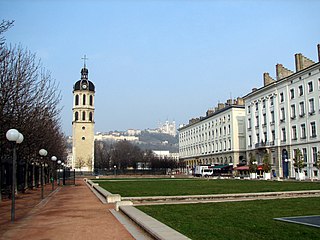
The Place Antonin-Poncet is a square located in the Bellecour quarter, near the Place Bellecour, in the 2nd arrondissement of Lyon, France. It is served by the metro station Bellecour of the lines A and D, and by many buses (10-12-14-15-29-30-35-53-58-88-99). The square belongs to the zone classified as World Heritage Site by UNESCO.

The Passage de l'Argue is a covered arcade in the Bellecour quarter, in the 2nd arrondissement of Lyon, which connects the rue de la République to the rue Édouard-Herriot and the rue de Brest. It is continued across rue de Brest by the Petit Passage de l'Argue, which was part of the main passage until the road was constructed. The Passage de l'Argue is one of the oldest arcades in the French provinces, built at the same period and on the same model as Parisian arcades. Home to many luxury retailers, it plays a significant role in the trade of the Presqu'île.

The Place Ampère is a pedestrian square located in the Ainay square, in the 2nd arrondissement of Lyon. It is nearly the middle of the rue Victor-Hugo and is served by the metro station Ampère - Victor Hugo.

The Place des Jacobins is a square located in the 2nd arrondissement of Lyon. It was created in 1556 and a fountain was added in 1856. The square belongs to the zone classified as World Heritage Site by UNESCO. According to Jean Pelletier, this square is one of the most famous in Lyon, because of its location in the center of the 2nd arrondissement and its heavy traffic, as 12 streets lead here. The square, particularly its architecture and its features, has changed its appearance many times throughout years.

The Place Sathonay is a square located in the 1st arrondissement of Lyon, France, at the bottom of hill of La Croix-Rousse, in La Martinière quarter. It was named after Nicolas-Marie-Jean-Claude Fay de Sathonay, mayor of Lyon from 1805 to 1812, as a tribute for all the importants works undertaken under his presidency. The square is currently the third largest square in Lyon and belongs to the zone classified as World Heritage Site by UNESCO. According to Lyon geography agrégé Jean Pelletier, it is "one of the most interesting squares of Lyon", because of its harmonious proportions, its boundaries composed of buildings with beautiful 1920s facades, and its plantations, which brings "a charm tinged of poetry" and give it the appearance of a village square.
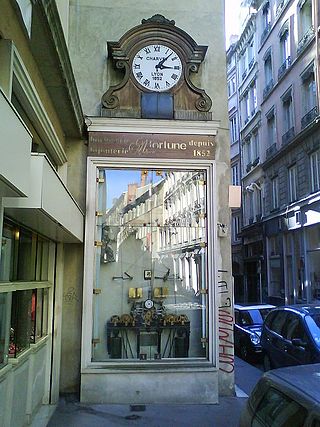
The Rue de la Poulaillerie is a street located in the 2nd arrondissement of Lyon, France. It was first named rue Vaudran, and also rue Maudite in reference to Peter Waldo, who founded what was considered a heresy at the time, the street received its current name from the fact that people exchanged poultry until 1835, when part of this trade emigrated to the covered market of La Martinière.

The Rue Lanterne is one of the oldest streets of Lyon, created in the Middle Ages, which is located in the 1st arrondissement of Lyon. It begins after the rue d'Algérie and ends against a facade of the rue Longue.

The Avenue du Maréchal de Saxe is a broad avenue located in the 3rd and the 6th arrondissements of Lyon. It was named after Maurice de Saxe, Marshal of France.
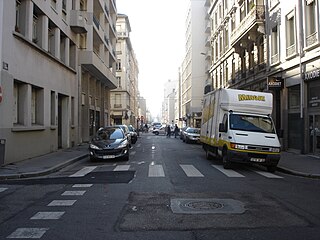
La Rue de Créqui is a very long street located in the 7th, 3rd and 6th arrondissements of Lyon. It is a long straight line along the rue Duguesclin or the rue de Vendôme, that begins on the Grande Rue de la Guillotière in the 7th arrondissement and ends at the north in the 6th, on the Boulevard des Belges. It follows the Place Guichard, located in the 3rd arrondissement.
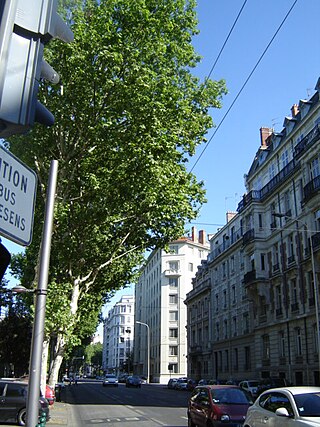
The Boulevard des Belges is a wide and posh avenue located in Les Brotteaux quarter, in the 6th arrondissement of Lyon. It begins with the Quai de Grande Bretagne, runs along the southern part of the Parc de la Tête d'Or until the Avenue Verguin and ends on the Place Jules Ferry, in front of the Gare des Brotteaux. The boulevard is lined with plane trees and is served by two velo'v stations and the line B of the metro.

The Rue du Bœuf is a 188-metre cobbled pedestrian street of the Vieux Lyon quarter, located in the 5th arrondissement of Lyon. Very representative of the Renaissance architecture of the neighborhood, it is lined only with old houses from the 16th or 17th century. The street connects the rue de Gadagne which it continues after the Place du Petit Collège and the intersection of the rue du Chemin Neuf, the rue de la Bombarde and the rue Tramassac which prolongs it. The street belongs to the zone classified as World Heritage Site by UNESCO.

The Place Benoît-Crépu is a stone-paved square, located in Saint-Georges quarter, on the banks of the Saône, in the 5th arrondissement of Lyon. It has fountains with dolphin heads, many benches and trees and a playground. The place belongs to the area classified as World Heritage Site by UNESCO.
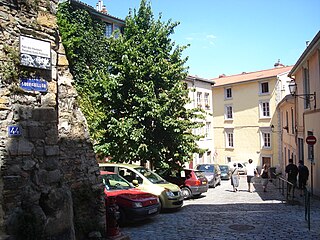
The Montée du Gourguillon is an old street in the 5th arrondissement of Lyon, France, on the hill of Fourvière, between the Saint-Jean and Saint-Just quarters. Montée translates in English to the nouns "climb" or "rise " and is given to a number of steep streets. The ancient Roman settlement of Lugdunum was established here in 43 BC. The montée du Gourguillon begins at the Place de la Trinité and ascends to the rue des Farges. Fourvière is known as "the hill that prays" because the Basilica of Notre-Dame de Fourvière, several convents, and the Archbishop's residence are located there. The street belongs to a zone classified by UNESCO as a World Heritage Site.

The Place Croix-Paquet is a square located in the 1st arrondissement of Lyon, in the pentes de la Croix-Rousse quarter. It is formed by the intersection of the rue du Griffon, the rue des Capucins and the montée Saint-Sébastien. The square belongs to the zone classified World Heritage Site by UNESCO.
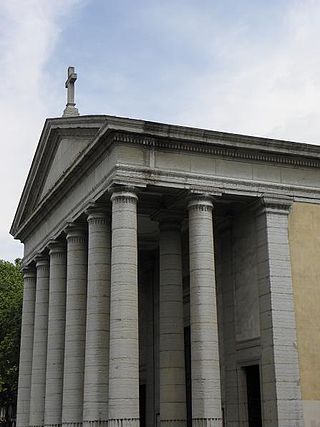
The Église Saint-Pothin is a Roman Catholic church located in Lyon, France. The parish church sits on the left bank of the Rhône, in the 6th arrondissement of Lyon, at the Place Edgar Quinet. By order of 2 May 2007, the whole church was included in the supplementary inventory of monuments historiques.
André Pelletier is a French historian and archaeologist, a professor and specialist of ancient Rome.
Daniel Moulinet is a French priest and historian, professor of contemporary history at the Catholic University of Lyon.

Claude Gauvard is a French historian and Middle Ages specialist. She has been the President of Société de l'histoire de France since 2009.
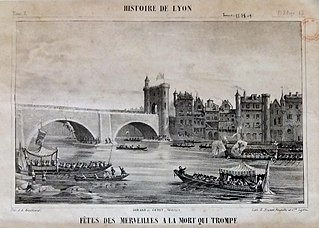
The Feast of Wonders or Feast of Miracles is both a religious and pagan ceremony that took place in Lyon on the banks of the Saône during part of the Middle Ages. It is inextricably linked with Saint Pothin's Day, a day of homage to the martyrs of Lyon in 177.